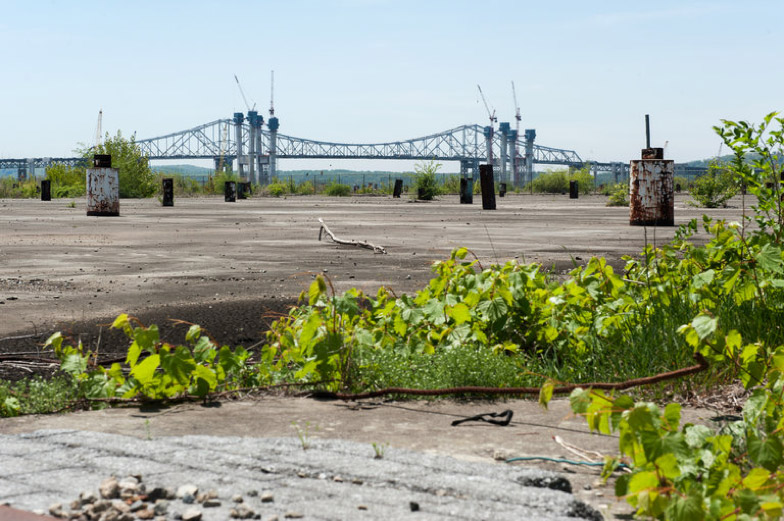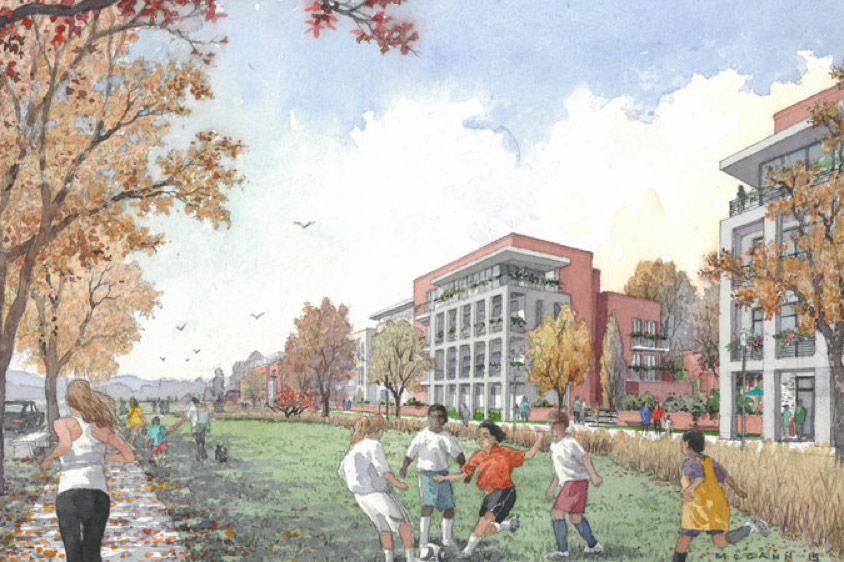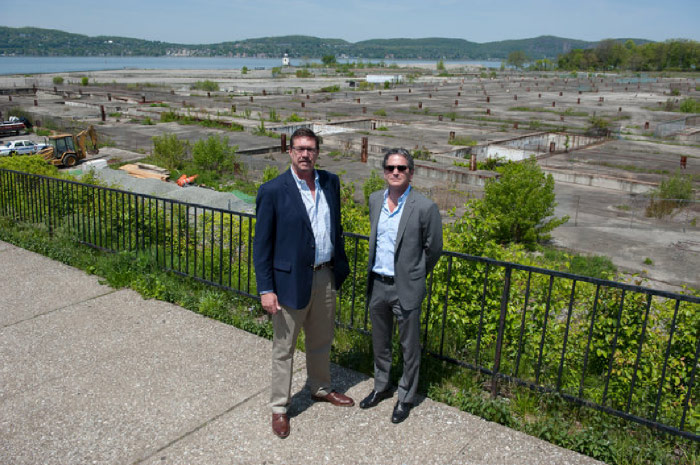May 18, 2016
Seeking Economic Jolt, Sleepy Hollow Embraces Development
$1 Billion Development on Former G.M. Site
LISA W. FODERARO
The New York Times

A development on the site of a former General Motors plant in Sleepy Hollow, N.Y., will feature 1,177 units of housing, more than 200,000 square feet of commercial space and a 140-room hotel. Credit Bryan Thomas for The New York Times
SLEEPY HOLLOW, N.Y. — It would seem ripe for an eruption of not-in-my-backyard furor — an enormous development along the water.
But instead, many in this corner of Westchester County welcome the project, believing it will provide the economic adrenaline that has long been needed, while resurrecting a long derelict industrial site that reflected the unraveling of manufacturing in the region.
The site — nearly 100 acres along the Hudson River here where General Motors once assembled 11 million cars — has had a protracted gestation period. On Wednesday, however, ground finally broke on the $1 billion development, which will feature 1,177 units of housing, more than 200,000 square feet of commercial space and a 140-room hotel.
When the project, Edge-on-Hudson, is completed over the next decade, it will transform this diverse village, where more than half of the 10,000 residents speak Spanish.
The ambitious plans are helping heal the wounds caused by the closing of the plant in 1996, which represented such a psychic shift for the village that officials changed its name — to Sleepy Hollow from North Tarrytown.
The name change evoked Washington Irving’s tale of “The Legend of Sleepy Hollow,” which has as its backdrop the village’s Old Dutch Church and churchyard. But the new moniker also signaled a changing economy, one based not on industry, but on history, the river — and housing.
“People are happy that it’s finally happening,” the village mayor, Ken Wray, a Democrat, said of the start of construction. “We’ve been looking at this empty slab for 20 years now. Plans and approvals are one thing, but it’s not the same as seeing someone out there with a jackhammer.”
The complex is expected to increase the population by a quarter and add an estimated 225 students to the school district. It could also lead to gentrification, especially along a stretch where low-rent housing sits close to the former General Motors site.

A rendering of the Edge-on-Hudson development that is planned to have 24 acres of public space, including 16 acres of parkland and trails, a 140-room hotel and 1,177 housing units. Credit Hart Howerton/Edge-On-Hudson
But residents and local officials, who have suffered through years of anemic tax revenue, are eager for the property to generate income. At one time, G.M. accounted for half of all tax revenue in the village. That fell to less than 5 percent after the company negotiated a deal in the 1980s that was designed to keep the plant in operation.
Right before G.M. sold the property to a development team in 2014, Sleepy Hollow, which has an annual budget of $21 million, received only $140,000 a year in taxes from the site. (After the plant closed, officials were forced to raise property taxes 20 percent in a single year.)
Now, with the site still a blank slate, tax revenue has already jumped to nearly $800,000 a year. That has enabled the village government to cut property taxes.
The tax benefits are not the only thing residents await. The developers,Diversified Realty Advisors and SunCal, worked with the environmental group Scenic Hudson, which years ago saw the potential of the former factory site to create open space on the Hudson.
As a result of discussions between Scenic Hudson, village officials, residents and the developers, the complex will include 24 acres of public space, including 16 acres of parkland and trails. Trails through the site will connect to RiverWalk, a planned 51-mile Hudson River path that is being built in stages. In addition, the new green space will border Kingsland Point Park, which is managed by the village.
The new open space will effectively expand the county park by 40 percent. “Kingsland Point Park will flow seamlessly into the park space for this development,” said Amy Kacala, a senior planner at Scenic Hudson. “That’s very exciting.”
In addition, local officials years ago had agreed on a plan that required any developer to give a large chunk of land to the village. Because Metro-North Railroad train tracks cross over the site, the most valuable land — from a developer’s perspective — is on the west side of the tracks along the river, with its majestic views.
About 30 acres of land on the east side of the railroad tracks has already been transferred to the village, which plans to build a new Department of Public Works building, along with a baseball diamond, an all-purpose athletic field and a recreation center.
Under the development agreement, SunCal and Diversified Realty Advisors have committed to paying the village $11.5 million to help finance those amenities.

From left, Peter Johnson and Jonathan D. Stein, both developers with the Edge-on-Hudson project, standing in front of what remains of a former General Motors operation where the mixed-use building will rise. Credit Bryan Thomas for The New York Times
The development came together at a glacial pace, in part because of concerns over its extraordinary size and in part because of the financial crisis of 2008. The first developer chosen by G.M., Roseland Property Company, decided to pull out when the neighboring village of Tarrytown sued over the plan’s density and traffic impacts.
“My partners outvoted me and we terminated the contract,” Jonathan D. Stein, a former partner in Roseland, said.
But Mr. Stein remained bullish about the site. Now a managing partner of Diversified Realty Advisors, he teamed up with SunCal, and the two firms together bought the property from G.M. for $39.5 million.
Over the next year, the developers will prepare the site for construction by ripping out acres of concrete foundation — all that remained after G.M. demolished its plant — and laying down utility lines.
Jim Tinson, chief executive of Hart Howerton, an architecture, landscape and planning firm, has arranged the site so that the buildings and open space facing the New York City skyline — visible beyond the Tappan Zee Bridge — are more urban and formal in design.
By contrast, the portion of the site that overlooks the rugged Hudson Highlands, where a lighthouse stands just offshore, was designed in a looser style, with native plantings and winding paths.
“As you turn the corner and pass the lighthouse, you see the Hudson River Valley and the pristine, undulating landscape in the distance,” said Mr. Tinson, whose firm is also the project’s master planner. “The parkland on our site becomes more organic and natural.”
Unlike some gated communities that have risen on the river, Edge-on-Hudson is intended to invite people to use the parkland, including a sandy beach for launching kayaks, and to patronize the shops and restaurants.
That is reassuring to Mr. Wray, the mayor. But he still wonders about the development’s repercussions on the village, where annual household incomes range from below the poverty line to over $1 million. (About 60 units in Edge-on-Hudson, or about 5 percent of the total, will be set aside for affordable housing.)
“We’re rightfully proud of who we are as a village and the diversity we have,” said Mr. Wray, who heads a foundation in New York City that promotes affordable housing. “I think gentrification will definitely happen, but the challenge of village government will be to maintain that diversity.”


